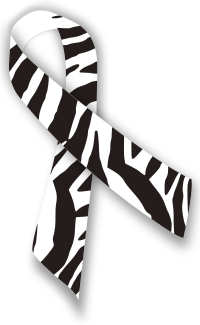|
Zebra print ribbon The zebra print ribbon is the awareness ribbon for uncommon or rare diseases and cancers including but not limited to neuroendocrine tumors, carcinoid cancer, Ehlers-Danlos Syndromes, Whipple's disease and awareness of other rare diseases, cancers and disorders. OriginThe zebra has been used as a symbol for rare diseases since around 1940. Dr. Theodore Woodward, a professor at the University of Maryland's School of Medicine[1] used this term to teach students the basics of diagnosing disease: "When looking at a patient's symptoms, it is better to assume it is a common ailment, not a rare one – a horse rather than a zebra."[1] UsageRare diseases and National Rare Disease DayNational Rare Disease Day (also known as Rare Disease Awareness Day) is held on February 29, but is moved up a day to February 28 on non-leap years.[2][3] This day was launched by the European Organization for Rare Diseases in 2008[4][5] and is now recognized worldwide. The date of February 29 was chosen because it is a "rare day" due to the leap year.[6] The symbol for rare disease awareness is a black and white striped ribbon.[7] In the US, the National Organization for Rare Disorders brings to light rare diseases, listing and defining more than 1,200 rare diseases that fall under the zebra awareness ribbon.[8] One of the rarest diseases on the list is the neuroendocrine tumors; this diagnosis has only been given to 2% of the cancers in the US. This cancer can go undiagnosed for a long time due to difficulty in detection and diagnosis.[9] Whipple's disease, another rare disease on the list, is a bacterial infection that is often mistaken for other diseases, requiring a biopsy of the stomach or duodenum looking for the bacteria Tropheryma whipplei.[10] Ehlers–Danlos syndromesThe zebra ribbon is also used for awareness of Ehlers–Danlos syndromes, a group of genetic connective tissue illnesses.[11] See alsoReferences
|